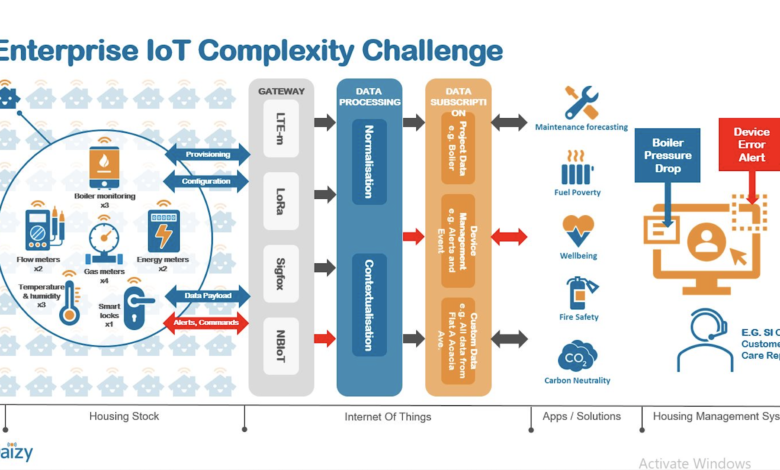
Social Housing providers share similar challenges around maintenance. Knowing the health of your building can often be an unknown, leading to the majority of repairs being reactive opposed to proactive. This is inconvenient for tenants, costlier to the business and can pose a higher risk to the health and safety of the number one priority…the customer.
It’s no surprise that housing providers are turning to technology to help solve this issue. Especially as during Covid times, when visiting customer homes was near impossible, it become even more crucial to look for a better solution that gave the landlord the necessary information without the customer being affected.
BCHA is one of the smaller housing providers in the UK, and has used the advantages of being agile, to begin an IoT project.
IoT and the social sousing sector
IoT, which stands for Internet of Things, has been around for 20 years now, but in the UK it is yet to take over in the social housing sector. Some housing associations and local authorities are running pilots, and IoT is beginning to gain momentum, with most having it as a key focus for the near future. BCHA has ran small pilots using three types of devices:
- Temperature and humidity devices, which take readings of the levels in a bathroom, sending alerts when they reach high figures.
- Emergency lighting devices, which can remotely carry out function tests and also notify if there are faults.
- Legionella water temperature devices, which detect flow rate and take temperature readings, sending an alert if a temperature is too high.
The Legionella water temperature device pilot was successful and nearly all BCHA homes, which currently need monthly visits from a contractor to take temperatures for Legionella control, now have these installed.
The idea behind IoT is that it is a physical device with attached sensors, often very small and always non-intrusive, which collects data and shares it via a communications network. There are plenty of Low Power Wide Area Network (LPWAN) options, available at very low cost. The devices range in price, but there are plenty of reasonably priced ones on the market.
Actionable data
So what to do with the data? Well, this depends on what it is you are monitoring and why. Using a temperature and humidity device as an example, you can check for high humidity. This is the top cause for creating damp and mould problems, which can be damaging to a customer’s health, as well as the building. As well as this, consistently low temperatures in colder months can provide early indication of fuel poverty. This gives landlords a chance to intervene and offer help to customers who may be in need of assistance, but who may be too afraid or too proud to ask.
So what are the benefits?
There are numerous benefits to be reaped from harnessing IoT technology both for landlords and customers, as well as all important wins from an environmental perspective.
Customer
For housing providers, improving engagement and building better customer relationships is a key focus and can be a challenge to get right. Too often we try and communicate with customers for our own benefit in order to gain valuable insight as to what we are doing right and, more importantly, what we are not. IoT flips this around and gives customers an opportunity to tell us what will give them the most benefit.
A great example of this are SMART heating controls, a simple yet effective way to control utility spend, and have a clearer view on how often and at what temperature to set the heating. They reduce costs to the customer and give them control over their homes.
Another clear benefit to the customer from these devices is the reduction in visits from a maintenance team or contractor. One of the reasons why BCHA decided to roll out the Legionella water temperature devices first, was to reduce the amount of visits required by a contractor. Customers do not want contractors in and out of their homes, so having access to the relevant data reduces the need for a landlord’s maintenance contractor to physically be there to obtain it.
From a health and safety perspective, IoT devices are extremely useful. No one wants to come home to a burst pipe or a smoke alarm sounding, both of which can be detected remotely with IoT devices. This allows the landlord to be alerted early on and gives them the chance to help before any damage is caused. It also means that the customer doesn’t have to report the issue.
Landlord
There are numerous benefits to the landlord from these devices:
- Removing unnecessary call outs and a decrease in the number of physical visits
- Prioritising maintenance
- Automating compliance reporting
- Removal of unnecessary business processes
- Creating a more efficient work force – fewer visits, less tenant disturbance
- Improving customer lives
Environment
Climate change is affecting the quality of our personal and work lives, but it is no surprise that technology can help make some significant improvements. The clear benefits from IoT to the environment come from energy efficiency and the reduction in physical visits.
A landlord of shared accommodation is able to use IoT to monitor their utilities, spotting peaks from a leak as an example, or where lights and heating are being left on unnecessarily. Educating customers on their impact on the environment is crucial and having that insight to the data will drive that.
The White Paper published by HACT last year goes into this in more detail – https://www.hact.org.uk/news/future-smart-social-home




wonderful!